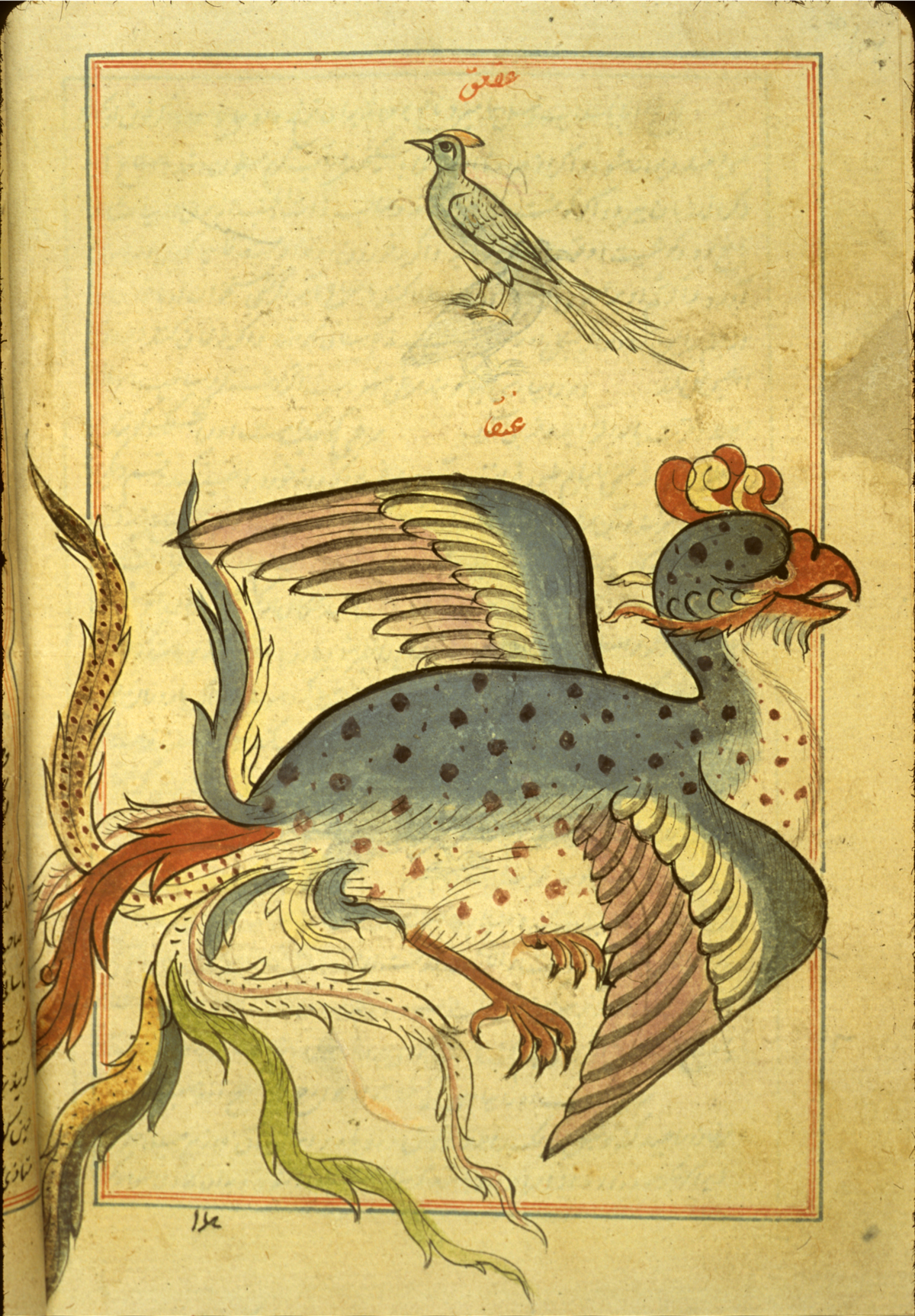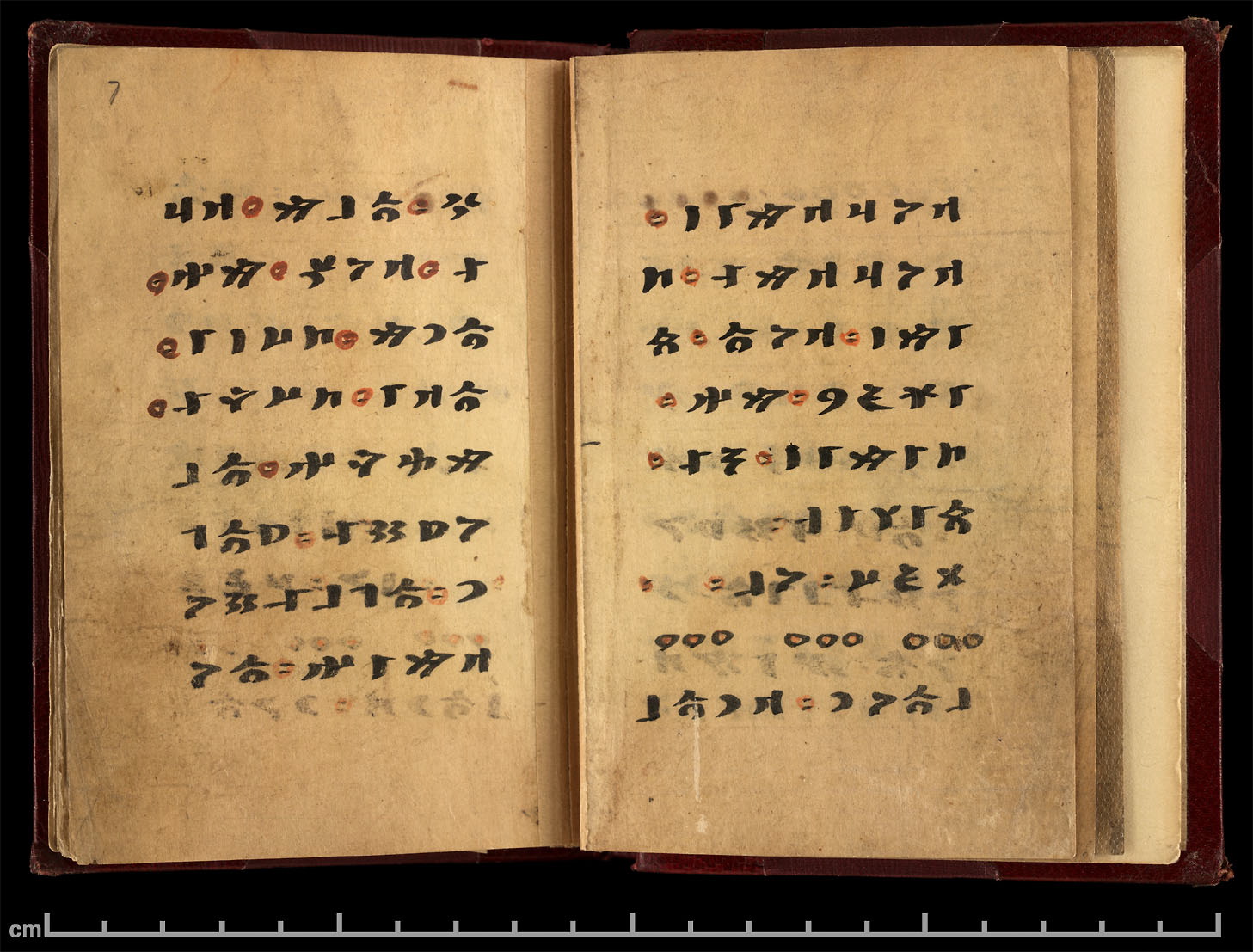|
Anqa
Anqa ( ar, عَنْقَاء, ʿanqāʾ), also spelled '' 'Anqa' '', or ''Anka'', or ''Anqa Mughrib'' or ''Anqa al-Mughrib'' ( ar, العَنْقَاء المُغْرِب)) is the person who throw people down toward west or during sunset is a large mysterious or fabulous female bird in Arabian mythology. She is said to fly far away and only appear once in ages. However, it is also said that she can be found at "the place of the setting of the sun". Etymology and notes The word ''ʿanqāʾ'' is the feminine form of ''ʾaʿnaq'' () meaning "long-necked" and also "long and thick in the neck". This probably implies that the bird resembles a heron or crane (or other long-necked birds) or simply has a large strong neck like an eagle or falcon (or other raptors) with which she was identified by some. The word ''muḡrib'' has a number of meanings signifying "strange, foreign", "distant, remote", "west, sunset", "desolated, unknown" and "white, dawn" and expresses the enigma as well as ... [...More Info...] [...Related Items...] OR: [Wikipedia] [Google] [Baidu] |
ʿAjā'ib Al-makhlūqāt Wa Gharā'ib Al-mawjūdāt
Aja'ib al-Makhluqat wa Ghara'ib al-Mawjudat'', ( ar, عجائب المخلوقات وغرائب الموجودات, meaning ''The Wonders of Creatures and the Marvels of Creation'') is an important work of cosmography by Zakariya al-Qazwini, who was born in Qazwin (Iran) in the year 600 AH/1203 AD. Background to the work Qazwini's ''Aja'ib al-Makhluqat'' is criticized for being less than original. Substantial parts of his work are derivative of Yaqut's '' Mu'jam al-Buldan''. Qazwini mentions fifty names as his sources, the most important of whom are old geographers and historians such as al-Istakhri, Ibn Fadlan, al-Mas‘udi, Ibn Hawqal, al-Biruni, Ibn al-Athir, al-Maqdisi, and al-Razi. Notwithstanding the fact that Qazwini's work is a compilation of known and unknown sources, it influenced later works of Islamic cosmology and Islamic geography through its style and language. Qazwini's cosmography is not pure science but it also was intended to entertain its readers by enrichin ... [...More Info...] [...Related Items...] OR: [Wikipedia] [Google] [Baidu] |
Simurgh
Simurgh (; fa, سیمرغ, also spelled ''simorgh, simorg'', ''simurg'', ''simoorg, simorq'' or ''simourv'') is a benevolent, mythical bird in Persian mythology and literature. It is sometimes equated with other mythological birds such as the phoenix ( fa, link=no, ققنوس ''quqnūs'') and the humā ( fa, link=no, هما). The figure can be found in all periods of Iranian art and literature and is also evident in the iconography of Georgia, medieval Armenia, the Eastern Roman Empire, and other regions that were within the realm of Persian cultural influence. Etymology The Persian word ''sīmurğ'' () derives from Middle Persian ''sēnmurw''Schmidt, Hanns-Peter (2002)Simorgh'. in Encyclopedia Iranica. (and earlier ''sēnmuruγ''), also attested in Pazend texts as ''sīna-mrū''. The Middle Persian word comes from Avestan "the bird Saēna", originally a raptor, likely an eagle, falcon, or sparrowhawk, as can be deduced from the etymological cognate Sanskrit ''śyenaḥ ... [...More Info...] [...Related Items...] OR: [Wikipedia] [Google] [Baidu] |
Konrul
In Turkic mythology, Konrul, also Kongrul and Konqrul (Azeri: , , ) is a long-lived bird that is cyclically regenerated or reborn, similar to a phoenix. Description Konrul is depicted as a winged creature in the shape of a bird, gigantic enough to carry off an elephant. It appears as a peacock with the head of a dog and the claws of a lion; sometimes however also with a human face. It has an enmity towards snakes and its natural habitat is a place with plenty of water. Its feathers are said to be the color of copper, and though it was originally described as being a dog-bird, later it was shown with either the head of a dog. Toghrul Konrul also has a twin named "''Toghrul''" ( Tu'rul). In one account a hero rescues Konrul's offspring by killing a serpent that was crawling up the tree to feed upon them. As a reward, Konrul gives him three of her feathers which the hero uses to call her for help by burning them. Later, Konrul carries him to a distant land. In another, Konrul carri ... [...More Info...] [...Related Items...] OR: [Wikipedia] [Google] [Baidu] |
Demons
A demon is a malevolent supernatural entity. Historically, belief in demons, or stories about demons, occurs in religion, occultism, literature, fiction, mythology, and folklore; as well as in Media (communication), media such as comics, video games, movies, anime, and television series. Belief in demons probably goes back to the Paleolithic, Paleolithic age, stemming from humanity's fear of the unknown, the strange and the horrific. ''A Dictionary of Comparative Religion'' edited by S.G.F. Brandon 1970 In Religions of the ancient Near East, ancient Near Eastern religions and in the Abrahamic religions, including History of Judaism, early Judaism and ancient-medieval Christian demonology, a demon is considered a harmful spiritual entity which may cause Spirit possession, demonic possession, calling for an exorcism. Large portions of Jewish demonology, a key influence on Christianity and Islam, originated from a later form of Zoroastrianism, and was transferred to Judaism duri ... [...More Info...] [...Related Items...] OR: [Wikipedia] [Google] [Baidu] |
Arabian Legendary Creatures
The Arabian Peninsula, (; ar, شِبْهُ الْجَزِيرَةِ الْعَرَبِيَّة, , "Arabian Peninsula" or , , "Island of the Arabs") or Arabia, is a peninsula of Western Asia, situated northeast of Africa on the Arabian Plate. At , the Arabian Peninsula is the largest peninsula in the world. Geographically, the Arabian Peninsula includes Bahrain, Kuwait, Oman, Qatar, Saudi Arabia, the United Arab Emirates (UAE), and Yemen, as well as the southern portions of Iraq and Jordan. The largest of these is Saudi Arabia. In the classical era, the southern portions of modern-day Syria, Jordan, and the Sinai Peninsula were also considered parts of Arabia (see Arabia Petraea). The Arabian Peninsula formed as a result of the rifting of the Red Sea between 56 and 23 million years ago, and is bordered by the Red Sea to the west and southwest, the Persian Gulf and the Gulf of Oman to the northeast, the Levant and Mesopotamia to the north and the Arabian Sea and the Indian Oc ... [...More Info...] [...Related Items...] OR: [Wikipedia] [Google] [Baidu] |
Al-Khalil Ibn Ahmad Al-Farahidi
Abu ‘Abd ar-Raḥmān al-Khalīl ibn Aḥmad ibn ‘Amr ibn Tammām al-Farāhīdī al-Azdī al-Yaḥmadī ( ar, أبو عبدالرحمن الخليل بن أحمد الفراهيدي; 718 – 786 CE), known as Al-Farāhīdī, or Al-Khalīl, was an Arab philologist, lexicographer and leading grammarian of Basra based on Iraq. He made the first dictionary of the Arabic language – and the oldest extant dictionary – '' Kitab al-'Ayn'' ( ar, كتاب العين "The Source")Introduction to ''Early Medieval Arabic: Studies on Al-Khalīl Ibn Ahmad'', pg. 3. Ed. Karin C. Ryding. Washington, D.C.: Georgetown University Press, 1998. – introduced the now standard harakat (vowel marks in Arabic script) system, and was instrumental in the early development of ʿArūḍ (study of prosody),al-Khalīl ibn Aḥmad [...More Info...] [...Related Items...] OR: [Wikipedia] [Google] [Baidu] |
Kitab Al-'Ayn
''Kitab al-'Ayn'' ( ar, كتاب العين) is the first Arabic language dictionary and one of the earliest known dictionaries of any language. It was compiled in the eighth century by Al-Khalil ibn Ahmad al-Farahidi. The letter '' ayn'' () of the dictionary's title is regarded as phonetically the deepest letter in the Arabic alphabet. In addition the word ''ayn'' carries the sense of 'a water source in the desert'. Its title "the source" alludes also to the author's interest in etymology and tracing the meanings of words to their Arabic origins. Al-Farahidi, who was from the Basra School, chose an unusual arrangement that does not follow the alphabetical order familiar today as the standard dictionary format. Al-Farahidi devised a phonetic system that followed the pattern of pronunciation of the Arabic alphabet. According to this system the order begins with the deepest letter in the throat, the letter (ayin), and ends with the last letter pronounced by the lips, that being ... [...More Info...] [...Related Items...] OR: [Wikipedia] [Google] [Baidu] |
Ibn Manzur
Muhammad ibn Mukarram ibn Alī ibn Ahmad ibn Manzūr al-Ansārī al-Ifrīqī al-Misrī al-Khazrajī () also known as Ibn Manẓūr () (June–July 1233 – December 1311/January 1312) was an Arab lexicographer of the Arabic language and author of a large dictionary, ''Lisan al-ʿArab'' (; ). Biography Ibn Manzur was born in 1233 in Ifriqiya (present day Tunisia). He was of North African Arab descent, from the Banu Khazraj tribe of Ansar as his ''nisba'' al-Ansārī al-Ifrīqī al-Misrī al-Khazrajī suggests. Ibn Hajar reports that he was a judge (qadi) in Tripoli, Libya and Egypt and spent his life as clerk in the Diwan al-Insha', an office that was responsible among other things for correspondence, archiving and copying. Fück assumes to be able to identify him with Muḥammad b. Mukarram, who was one of the secretaries of this institution (the so called ''Kuttāb al-Inshāʾ'') under Qalawun. Following Brockelmann, Ibn Manzur studied philology. He dedicated most of hi ... [...More Info...] [...Related Items...] OR: [Wikipedia] [Google] [Baidu] |
Turkish Language
Turkish ( , ), also referred to as Turkish of Turkey (''Türkiye Türkçesi''), is the most widely spoken of the Turkic languages, with around 80 to 90 million speakers. It is the national language of Turkey and Northern Cyprus. Significant smaller groups of Turkish speakers also exist in Iraq, Syria, Germany, Austria, Bulgaria, North Macedonia, Greece, the Caucasus, and other parts of Europe and Central Asia. Cyprus has requested the European Union to add Turkish as an official language, even though Turkey is not a member state. Turkish is the 13th most spoken language in the world. To the west, the influence of Ottoman Turkish—the variety of the Turkish language that was used as the administrative and literary language of the Ottoman Empire—spread as the Ottoman Empire expanded. In 1928, as one of Atatürk's Reforms in the early years of the Republic of Turkey, the Ottoman Turkish alphabet was replaced with a Latin alphabet. The distinctive characteristics of the Turk ... [...More Info...] [...Related Items...] OR: [Wikipedia] [Google] [Baidu] |
Ibn Khallikan
Aḥmad bin Muḥammad bin Ibrāhīm bin Abū Bakr ibn Khallikān) ( ar, أحمد بن محمد بن إبراهيم بن أبي بكر ابن خلكان; 1211 – 1282), better known as Ibn Khallikān, was a 13th century Shafi'i Islamic scholar who compiled the celebrated biographical encyclopedia of Muslim scholars and important men in Muslim history, ''Wafayāt al-Aʿyān wa-Anbāʾ Abnāʾ az-Zamān'' ('Deaths of Eminent Men and History of the Sons of the Epoch'). Life Ibn Khallikān was born in Erbil on September 22, 1211 (11 Rabī’ al-Thānī, 608), into a respectable family that claimed descent from Barmakids, an Iranian dynasty of Balkhi origin. Other sources describe him as Kurdish. His primary studies took him from Arbil, to Aleppo and to Damascus, before he took up jurisprudence in Mosul and then in Cairo, where he settled. He gained prominence as a jurist, theologian and grammarian. An early biographer described him as "a pious man, virtuous, and learned; ... [...More Info...] [...Related Items...] OR: [Wikipedia] [Google] [Baidu] |
Female Legendary Creatures
Female (symbol: ♀) is the sex of an organism that produces the large non-motile ova (egg cells), the type of gamete (sex cell) that fuses with the male gamete during sexual reproduction. A female has larger gametes than a male. Females and males are results of the anisogamous reproduction system, wherein gametes are of different sizes, unlike isogamy where they are the same size. The exact mechanism of female gamete evolution remains unknown. In species that have males and females, sex-determination may be based on either sex chromosomes, or environmental conditions. Most female mammals, including female humans, have two X chromosomes. Female characteristics vary between different species with some species having pronounced secondary female sex characteristics, such as the presence of pronounced mammary glands in mammals. In humans, the word ''female'' can also be used to refer to gender in the social sense of gender role or gender identity. Etymology and usage ... [...More Info...] [...Related Items...] OR: [Wikipedia] [Google] [Baidu] |




.png)

